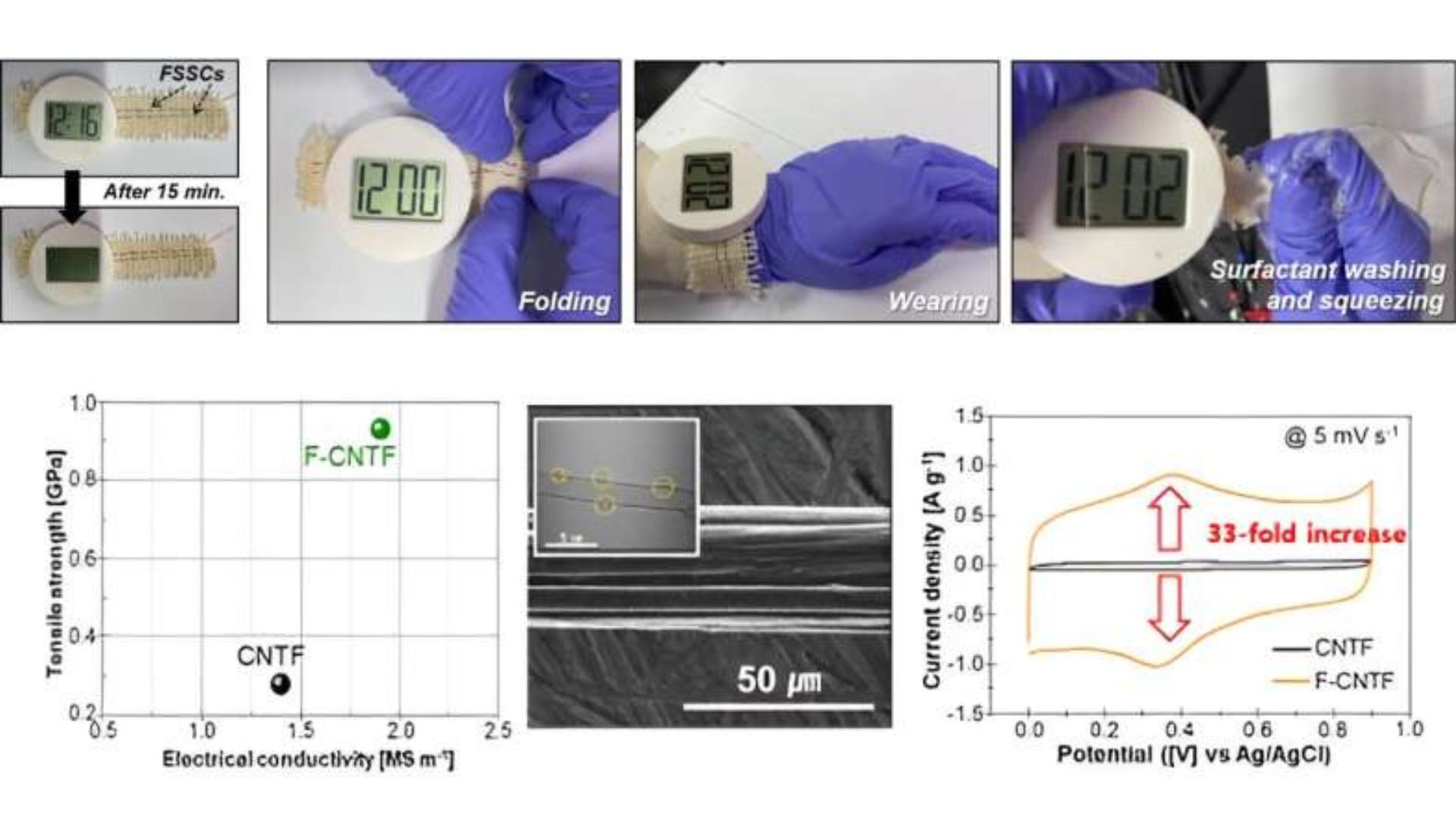Advancements in wearable devices have necessitated the development of lightweight and robust energy storage systems.
These requirements mainly demand technology that enables power retention and energy density under various mechanical deformation conditions.
In a step in the right direction, researchers at the Korea Institute of Science and Technology (KIST) have now developed a fiber-like electrode material that can store energy.
According to the team, with advanced strength, lightness, and flexibility, these fibers offer unprecedented versatility in wearable device design. The technology can empower the creation of diverse shapes and applications, granting newfound freedom in form factors.
The details of the team’s research were published in the journal Advanced Energy Materials.

Carbon nanotube fibers transformed into fiber-like supercapacitors showcase energy storage prowess in a digital watch, boasting a 33x electrochemical activity boost.
Innovating carbon nanotube fibers
Fiber-shaped supercapacitors (FSSCs) are getting attention for wearable energy storage because they can blend seamlessly into various shapes, much like regular fibers.
Carbon nanotube fibers (CNTFs) are perfect for these devices because they conduct electricity well, are strong, and are flexible. According to the team, CNTFs made using a wet-spinning process in a liquid crystal phase show excellent traits like high electrical conductivity, robust strength, lightweight, and flexibility.
These great qualities come from the fiber’s tightly packed and aligned structure and the fact that it’s made of highly crystalline carbon nanotubes with few defects.
However, there’s a catch. The clean surface of CNTFs doesn’t provide much space for chemical reactions, which limits their use in FSSCs. To make the most of their great traits in FSSCs, engineers need to find a way to boost their ability to react chemically without losing what makes them special.
Researchers have been adding extra materials to carbon nanotube fibers (CNTFs) ‘ surfaces to boost their ability to store energy. These materials, like conducting polymers or metal oxides, increase the surface area for chemical reactions.
However, this method has drawbacks. The added materials might come off during use, and the process is unsuitable for making long, continuous fibers. Researchers highlight the need for a new way to improve CNTFs for energy storage without adding extra materials, making it cheaper and more practical.
Future of fiber-based batteries
As a solution, the KIST team developed special carbon nanotube fibers (CNTFs) that can store energy well without needing extra steps or materials.
These fibers are made by treating the surface of CNTs, turning them into a special liquid crystal form, and then spinning them into fibers. Treating the surface of CNTs can normally improve their energy storage but also make them less conductive.
To solve this, researchers made the liquid crystal solution extra concentrated, which made the fibers stronger and better at conducting electricity. Compared to regular CNT fibers, the treated ones can store much more energy and are better at conducting electricity.
Modified carbon nanotube fiber showed 33 times more energy storage, 3.3 times more strength, and 1.3 times more conductivity than regular fibers. The team tested these fibers by making them into energy storage devices and using them to power a digital clock, which worked well for over 15 minutes.
In studies using fiber-shaped supercapacitors, they maintained 95 percent of their performance after 5,000 bending tests and almost 100 percent when knotted. Researchers claim that after being bent, folded, and cleaned, they also functioned well when woven into the wrist straps of digital timepieces using a blend of normal and carbon nanotube fibers.
“We have confirmed that carbon nanotubes, which have recently started to attract attention again as a conductive material for secondary batteries, can be used in a much wider range of fields,” said Dr. Kim Seung-min, a researcher at KIST.
The team plans to extend its research for unconventional energy storage applications. Additionally, they are exploring ways to adapt this technology for fiber-type batteries with increased energy density, moving beyond supercapacitors.




